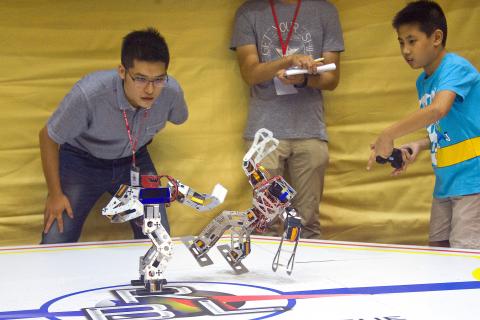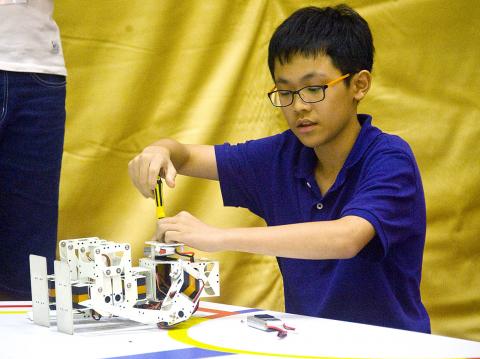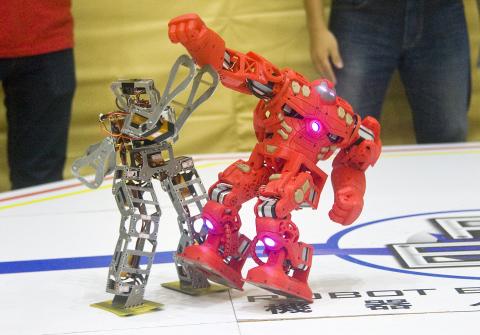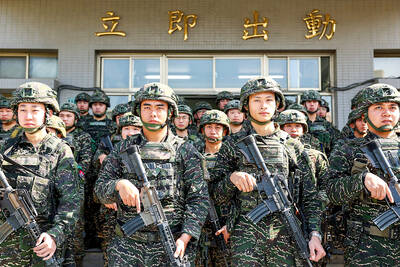When Lu Tsung-yung (盧聰勇) held the first Robot Boxing Competition five years ago, more than 40 of the 62 constructions couldn’t even walk successfully.
“Basically, if you could even make your robot take a step, you won your round,” Lu laughs.
Nine competitions later, Lu says the mechanical gladiators have become so advanced that he has had to enlarge the ring and is thinking of another expansion. He’s also thrown in new challenges during last weekend’s event it was slope descending, which not a single robot passed.

Photo: Han Cheung, Taipei Times
“We’ve had the robots ascend and descend stairs for the past two years and the contestants seem to have that figured out already,” Lu says. “So I added the slope. When someone figures that out, we’ll mix it up again. It’s brutal. What you see here is five years of evolution.”
LIKE HUMAN
Held at DMP Electronics (瞻營全電子股份有限公司), an electronics and robot parts company in Hsinchuang District’s (新莊) industrial area in New Taipei City, this competition — unlike often depicted in movies — is no simple slugfest between two bumbling metal stiffs.

Photo: Han Cheung, Taipei Times
Set to a soundtrack of intense video game-esque speed metal, robots under 3kg deftly maneuver around the ring, throwing punches and kicks, dodging and grappling while shifting their weight around to avoid a knockdown. It’s fast-paced, entertaining stuff to watch, complete with a referee yelling out the results. At the end of the three-minute round, the robot that gets knocked down by a legitimate attack the fewest times wins.
To score a “down,” the attacker has to remain standing. But referee Wu Chia-hsien (吳佳憲) says the number one thing he watches for is the intent of a certain move.
“We have to be able to tell if it was a complete attack — if the punch was properly executed and if it hit the other robot in a spot where it could fall over,” he says.

Photo: Han Cheung, Taipei Times
“If you accidentally topple the opponent during a part of a movement, such as retracting your fist from an unsuccessful attack — that doesn’t count.”
Wu says the rules have been refined over the years. He cites an example of some contestants’ strategy of moving and attacking sideways or while in a squatting position to avoid falling. That has since been banned, as Lu wants this to be realistically anthropomorphic as possible.
Lu says there are many “schools” in robot building — he believes in making and promoting bipedal robots, while others may favor wheels or tentacles
“That’s why we place such an emphasis on walking, fighting and staying upright,” he says. “When you watch movies, the robots are usually bipedal because they need to do many things, and with two feet you aren’t as limited by the terrain around you.”
Robotics instructor Liu Chun-ming (劉俊民) says that he always asks his students to physically perform a maneuver first before programming the robot to do it. Part of it is to look realistic, but also to teach them that if a human cannot do something, a humanoid robot should not either.
“If they perform the move and feel pain or discomfort, then they should not make the robot do it,” Liu says. “The robot cannot cry out in pain, but its motor might start smoking.”
DUELING MACHINES
The finals are in action by the afternoon — with 24 warriors standing. It’s a mix of demographics — ranging from fourth-graders to adults. There’s a group from Macau, and there’s one lone female, an engineering student at Chenghsiu University (正修大學), whose instructors and several classmates are also in the final fray.
Most robots are built along the same vein and prototype, with minor modifications such as fists or shovels as hands. A contestant with a claw robot says it simply is aesthetic preference. The construction that stands out the most is a replica of Iron Man’s Hulkbuster armor, made by Mike Chen (陳念勤) using 3D printing technology.
Chen works in a family team — he designs and prints the parts, his brother programs the action and his nephew operates the product on the battlefield. They originally started making robots for this competition, but now have branched into other areas of robotics.
“The fun is in the process,” Chen says. “I didn’t put too much thought into the design — the point was to think of how to use 3D printing, seven motors and other parts to make a moving Iron Man. Can it beat others? We don’t know.”
Alas, Iron Man suffers a bad connection with its controller and has trouble getting up, losing points. After taking a two-minute timeout to fix the problem, it is knocked out of competition.
Meanwhile, the Chenghsiu students keep advancing. The final battle is between classmates, the Black Knight (黑武士) and Fashion Pioneer (時尚尖兵). The more experienced Black Knight, controlled by Ko Shih-tung (葛士冬), makes it out on top.
Ko doesn’t think much of his accomplishment, at least on the surface, as he stoically walks off the stage and starts packing his bags.
“It’s just luck,” he says. “There’s nothing special to this.”
His robotics teacher, Hu Che-wei (胡哲瑋), steps in: “Instead of going on vacation, they’ve been coming to my robotics classroom to practice three times a week this summer. Also, the Black Knight’s programming is better than that of his opponent. You can tell that his movements are more fluid.”
Ko disagrees, as Hu was knocked out in the first round of the finals. “Even if I write really good code, it’s not going to be better than my teacher’s,” he says.
For more information on upcoming competitions, visit www.facebook.com/RobotBoxing.

That US assistance was a model for Taiwan’s spectacular development success was early recognized by policymakers and analysts. In a report to the US Congress for the fiscal year 1962, former President John F. Kennedy noted Taiwan’s “rapid economic growth,” was “producing a substantial net gain in living.” Kennedy had a stake in Taiwan’s achievements and the US’ official development assistance (ODA) in general: In September 1961, his entreaty to make the 1960s a “decade of development,” and an accompanying proposal for dedicated legislation to this end, had been formalized by congressional passage of the Foreign Assistance Act. Two

President William Lai’s (賴清德) March 13 national security speech marked a turning point. He signaled that the government was finally getting serious about a whole-of-society approach to defending the nation. The presidential office summarized his speech succinctly: “President Lai introduced 17 major strategies to respond to five major national security and united front threats Taiwan now faces: China’s threat to national sovereignty, its threats from infiltration and espionage activities targeting Taiwan’s military, its threats aimed at obscuring the national identity of the people of Taiwan, its threats from united front infiltration into Taiwanese society through cross-strait exchanges, and its threats from

Despite the intense sunshine, we were hardly breaking a sweat as we cruised along the flat, dedicated bike lane, well protected from the heat by a canopy of trees. The electric assist on the bikes likely made a difference, too. Far removed from the bustle and noise of the Taichung traffic, we admired the serene rural scenery, making our way over rivers, alongside rice paddies and through pear orchards. Our route for the day covered two bike paths that connect in Fengyuan District (豐原) and are best done together. The Hou-Feng Bike Path (后豐鐵馬道) runs southward from Houli District (后里) while the

March 31 to April 6 On May 13, 1950, National Taiwan University Hospital otolaryngologist Su You-peng (蘇友鵬) was summoned to the director’s office. He thought someone had complained about him practicing the violin at night, but when he entered the room, he knew something was terribly wrong. He saw several burly men who appeared to be government secret agents, and three other resident doctors: internist Hsu Chiang (許強), dermatologist Hu Pao-chen (胡寶珍) and ophthalmologist Hu Hsin-lin (胡鑫麟). They were handcuffed, herded onto two jeeps and taken to the Secrecy Bureau (保密局) for questioning. Su was still in his doctor’s robes at